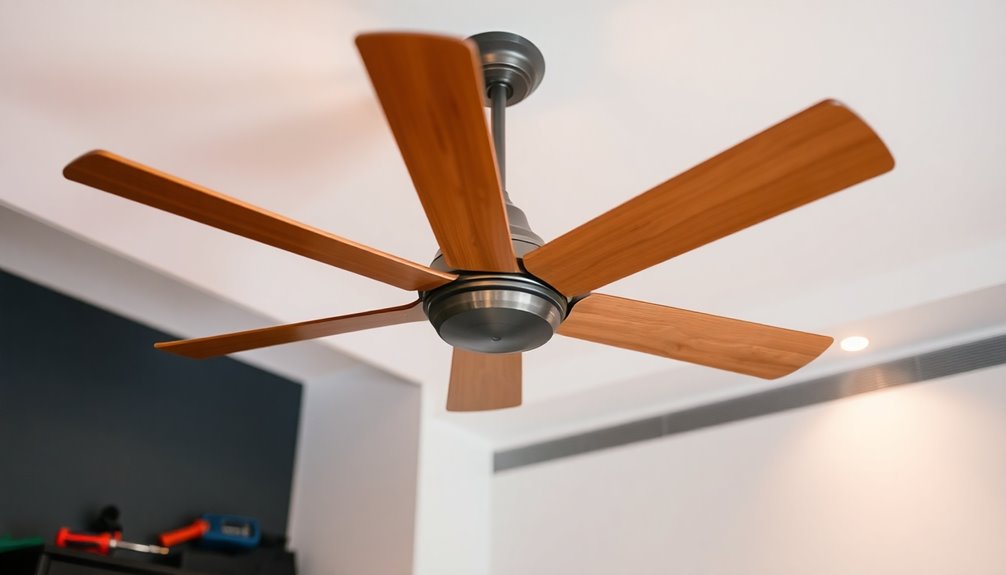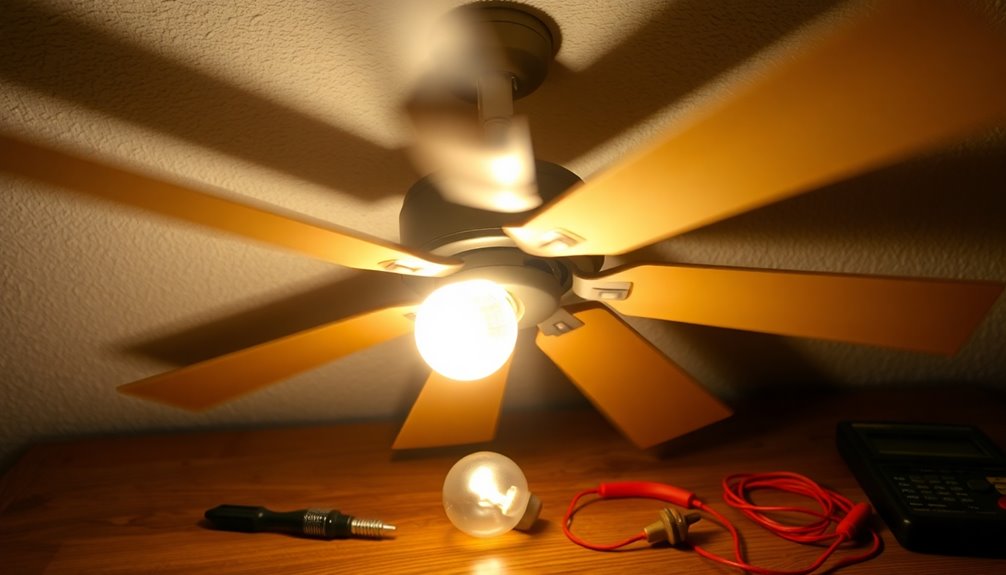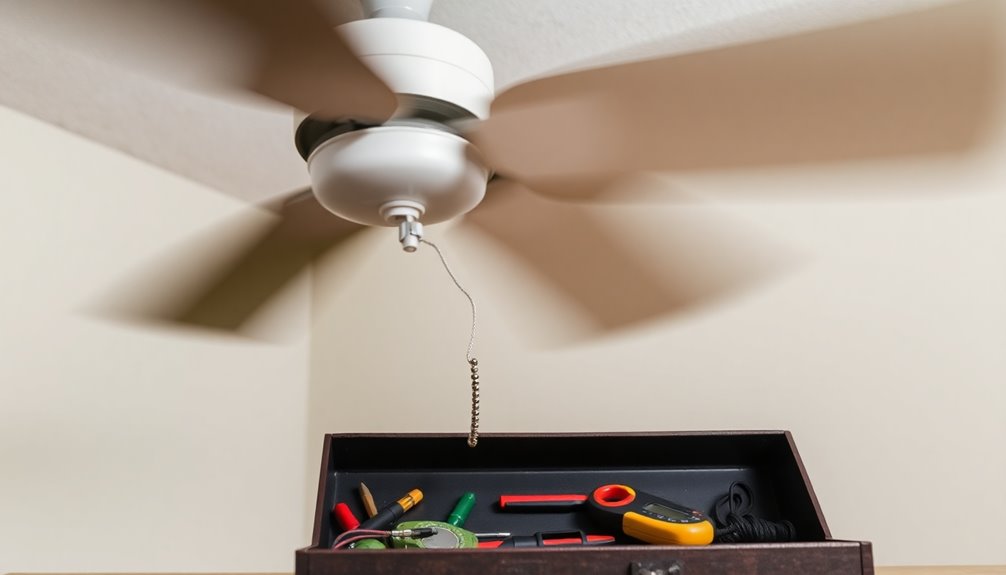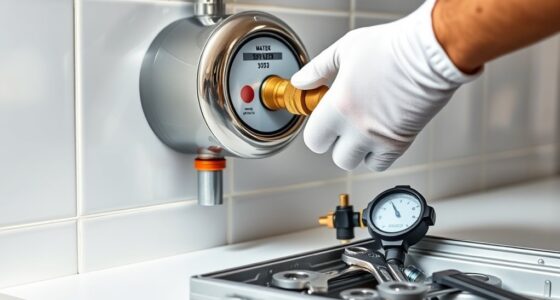If your ceiling fan only works on high speed, it usually means there's an issue with the pull chain switch, capacitor, or motor. You should first check the pull chain switch to see if it's functioning correctly. Next, inspect the capacitor for any signs of damage, like bulging or melting. If both appear fine, the motor might be at fault. You can easily replace the pull chain switch or capacitor if they're the culprits. Remember, if these fixes don't resolve the problem, further options are available that could help restore your fan's functionality.
Key Takeaways
- Check the pull chain switch for functionality; it may be malfunctioning and unable to change speed settings.
- Inspect the capacitor for damage; bulging or melting indicates failure and can disrupt speed control.
- Bypass the pull chain switch to directly test the motor and see if it operates at different speeds.
- Replace the pull chain switch or capacitor if they are faulty to restore proper speed control.
- If issues persist, consult an electrician to assess wiring or consider replacing the ceiling fan.
Common Symptoms of Speed Issues

When your ceiling fan only runs on high speed, it's a clear sign something's off. You might notice that the pull chain switch isn't effectively changing the circuits for medium and low settings.
This malfunction can often be linked to capacitor failure, as it regulates the fan's speed. If you find the fan shutting off during medium or low settings, overheating could be the issue, possibly due to motor damage after prolonged duration of operation.
Keep an eye out for visual signs of capacitor damage, like bulging or melting, which indicate it needs replacement. Additionally, wiring problems within the fan can lead to inconsistent performance, necessitating a thorough inspection to resolve speed issues.
Identifying Potential Causes

To identify the potential causes of speed issues in your ceiling fan, you'll want to focus on several key components.
| Component | Common Issue |
|---|---|
| Pull Chain Switch | Fails to change speed settings |
| Capacitor | Capacitor failure affects speed control |
| Wiring Issues | Disrupts communication between components |
| Electrical Components | Older fans may degrade over time |
Faulty ceiling fan motors can also lead to high speed operation only. Regular maintenance is essential; inspecting these parts can help you catch problems early. If you notice overheating or bubbling in the capacitor, or if the fan performance seems off, these might signal underlying issues requiring your attention.
Troubleshooting Steps to Take

Before diving into repairs, it's essential to follow a systematic approach to troubleshoot your ceiling fan.
Here are three key steps to guarantee you identify the issue accurately:
- Test the Pull Chain Switch: Use an AC voltmeter to check its functionality across all speed settings.
- Inspect the Capacitor: Look for any signs of damage, like bubbling or overheating, which indicates it may need replacement.
- Bypass the Switch: Temporarily connect the motor directly to test the capacitor's functionality and see if the fan runs at different speeds.
Lastly, document the wiring configuration before disassembly, assuring you can reassemble correctly.
If the pull chain switch is faulty, you'll need to replace it with a compatible model to restore proper functionality.
Repair and Replacement Options

Repairing or replacing components of your ceiling fan can often be straightforward. If your fan only operates on high speed, check the pull chain switch; replacement is easy and available at local retailers.
Capacitor failure may also prevent speed adjustments, so locate and replace the rectangular black plastic component under the motor housing. For enhanced control, consider installing a remote control system, which usually costs around $40.
If multiple speeds fail, fan replacement might be the best option, as new models often have integrated speed control features.
Don't forget regular maintenance, including cleaning and lubricating components, to extend your fan's lifespan and minimize future repairs.
These repair options can keep your ceiling fan functioning smoothly.
When to Seek Expert Help

Sometimes, even with proper maintenance and DIY fixes, your ceiling fan may still have issues that require professional attention.
If you notice any of the following, it's time to seek expert help:
- Persistent speed control issues indicating a faulty pull chain switch or capacitor.
- Physical signs of damage like bulging or leaking capacitors that pose safety risks.
- Failed DIY troubleshooting efforts that leave you worried about potential electrical hazards.
An experienced electrician can assess wiring configurations and provide a safe, effective solution.
Don't risk further damage or safety concerns—consult a professional to guarantee your ceiling fan operates properly and safely.
Prioritizing your safety and peace of mind is always worth it.
Frequently Asked Questions
Why Does My Ceiling Fan Only Work on High Speed?
If your ceiling fan only works on high speed, it might be due to a faulty pull chain switch or a damaged capacitor.
Loose wiring connections can also lead to this problem, forcing the fan to operate only at high speed.
Dust and debris buildup may impede the motor's function, causing similar issues.
Regular maintenance, like cleaning and checking connections, can help you identify the root cause and restore your fan's functionality.
Why Is My Ceiling Fan Not Working on Low Speed?
Did you know that nearly 40% of ceiling fan issues stem from problems with speed settings?
If your ceiling fan isn't working on low speed, you might be dealing with a faulty pull chain switch or a malfunctioning capacitor. Worn wiring could also be the culprit, leading to inconsistent performance.
Regular cleaning can help prevent dust buildup, ensuring your fan operates smoothly at all speeds.
Don't forget to check connections for peak functionality!
Why Does My Ceiling Fan Not Work on Medium Speed?
If your ceiling fan doesn't work on medium speed, there could be a few issues at play.
You might've a faulty pull chain switch that's failing to connect properly, or the capacitor could be malfunctioning, preventing the fan from operating at lower speeds.
It's also possible that there are wiring issues inside the fan affecting speed control.
Inspecting these components can help you pinpoint the problem and find a solution.
How Do I Know if My Ceiling Fan Capacitor Is Bad?
To know if your ceiling fan capacitor is bad, look for physical signs like bulging or leaking fluid.
You can also use a multimeter to test its capacitance; if the reading is considerably lower than the rated value, it's likely failed.
Remember, capacitors usually last around 10 years, so age could be a factor.
If you see damage or get a low reading, you should replace the capacitor to restore functionality.
Conclusion
To conclude, if your ceiling fan only works on high speed, don't worry—you're not alone. For instance, a homeowner named Sarah discovered that a faulty speed control switch was the culprit behind her fan's issue. After replacing it, her fan worked perfectly again on all settings. So, whether you tackle the problem yourself or call in a pro, addressing speed issues can restore your comfort and keep your space cool. Don't hesitate to take action!









